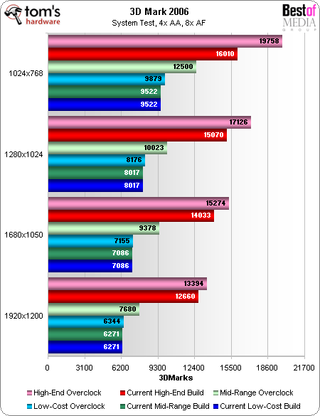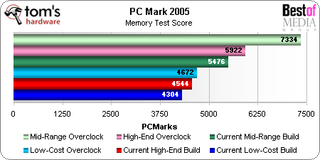System Builder Marathon: Price/Performance
Synthetics

3D Mark's basic settings show the low-cost system gaining only 8% from overclocking. Meanwhile the mid-priced and high-end systems lead the lowest score by 32% and 101%.

Enabling 4x AA and 8x AF spread the maximum difference between high and low cost configurations to 112%.

PC Mark's system test shows a smaller 54% maximum difference in system performance.

PC Mark's CPU test scale almost perfectly with clock speed, leading to a maximum performance difference of 118%.

PC Mark's Memory Test puts the overclocked mid-priced build in the lead.
Stay on the Cutting Edge
Join the experts who read Tom's Hardware for the inside track on enthusiast PC tech news — and have for over 25 years. We'll send breaking news and in-depth reviews of CPUs, GPUs, AI, maker hardware and more straight to your inbox.
-
It's an amazing comparison....!!!Reply
However, it would be appropriate to raise the cost of the low-cost system to $1,000, to corrolate systems that cost $1,000, $2,000 and $4,000 for better distinction, then the low cost alternatve could shine as a value option, with E8500 CPU, 2x2 GB RAM and a 750 GB storage. -
Retrogame What I took away from this was examples of how the systems actually behave. Naturally, if you're spending $4000 on hardware and that doesn't even include your OS and your screen, you want and expect a system that's "really really really fast". You can get that.Reply
However, the second thing I was paying attention to was how the lower end system did in "real world" terms. Except for Crysis, it actually did pretty well on most things, and gave you games that were playable. When it comes to the other benchmarks, sure, you can "render that video in a minute's faster time"; but then again, in the real world, you would be working on something that takes many more minutes to render; long enough that you would probably work on something else in the mean time, or still go for a cup of coffee.
Or you can rip that CD faster, but, then again, now that we're in the realm of mere seconds, is saving less than a minute really of actual value? Not several thousand dollars worth of value.
I think I'm like most people and would shoot for the overclocked middle system.
I still remember the days when rendering took over night! -
ikesysmi -- firstly, please forgive me if use terminology incorrectly or i sound unfamiliar with this territory (because actually i am). a former it help desk supervisor for 23 years and career cut short to disability a few years ago. so ... i've been out of the "loop" for awhile, although the "game" still interests me despite disabilities ... thank you.Reply
-- as for the tom's website and this forum ... today's my first encounter (my b'day of all days! great resource / forum here!
I am considering building a PC for me to work from home / build a new home business vie the web. I've been researching for days (and nights) now and this article was a blessing! Looking for a system that would blow the doors off Photoshop, AutoCad and the like ... here's my take ...
By the way ... I did what most of us do and went right to the "conclusion" writing first. Only then when I see the hype over the "low-end" system did I go back to the beginning; sorry, i just learned to read that way (ex-IBM'r and just loved to read cover to cover those shelves of 3-inch thick IBM manuals lining my office shelves ... if ya' know what i mean ... ~wink~). Anyway ...
Turns out that for me (and potentially other digital "image doodlers" as well), that the middle of the road works especially well: 1.The study here shows (as for overclocked applications are compared) that the likes of Photoshop noticed almost a 100% percent performance gain over the low-end system (the one i almost built), 2.While middle system showed a performance gain of anywhere from 34% to 94% on applications, the low end system only seen a 7%-13% gain! Wow! That's "valuable" to me! and 3.The most noticable difference between middle / low systems is with the likes of Photoshop and 3D rendering! Right up my ally! Yes it costs me 131% more to build but in my case, I can't pass up a potential for a 100% percent gain in productivity! And finally, the article points out that mid$ systems when overclocked actually surpass the hi$ systems base-speed. So, that tells me that the best thing for me to do is to find the least costly, middle of the road system to build but make sure that the components are as upgradable as possible so that in the future (say 6 months from now), when the next photoshop upgrade calls for more and more system resources ... i'll not need to throw it out and start over again from scratch!
Thanks guys ... fantastic article! Saved me tons of wasted time!
-
ikesysmi RetrogameWhat ... Or you can rip that CD faster, but, then again, now that we're in the realm of mere seconds, is saving less than a minute really of actual value? Not several thousand dollars worth of value. I think I'm like most people and would shoot for the overclocked middle system.I still remember the days when rendering took over night!Reply
I'm from the days when "rendering" meant that the IT manager summoned the department gopher (me in those days) to "render" her another cup of coffee!
In all seriousness though ... you make an excellent point here ...
Not so long ago, I remember my computer users asking back in the day when the PS/2 came to replace our 40286-processor AT's ... "What the heck we need PS/2 for anyhow?" Heck, we were running dual-display, 286 AT workstations for AutoCad for goodness sake! And we spent quite a pretty penny for those systems! I even remember my IT boss commenting to the computer staff that the fixed disk was just a fad and there wasn't any software that could take advantage of it ... and therefore ... she bucked buying systems with hard drives for years and wanted management to continue paying for her overpriced, turtle-speed mainframe!
So, the point I make here I guess is ... That millisecond or two we're laughing about right now will add up and it won't be too long into the future when you'll be looking back and telling your grandkids about the first multi-terrabyte machines that came out ... way way back in the early 2000's !!!
Most Popular


